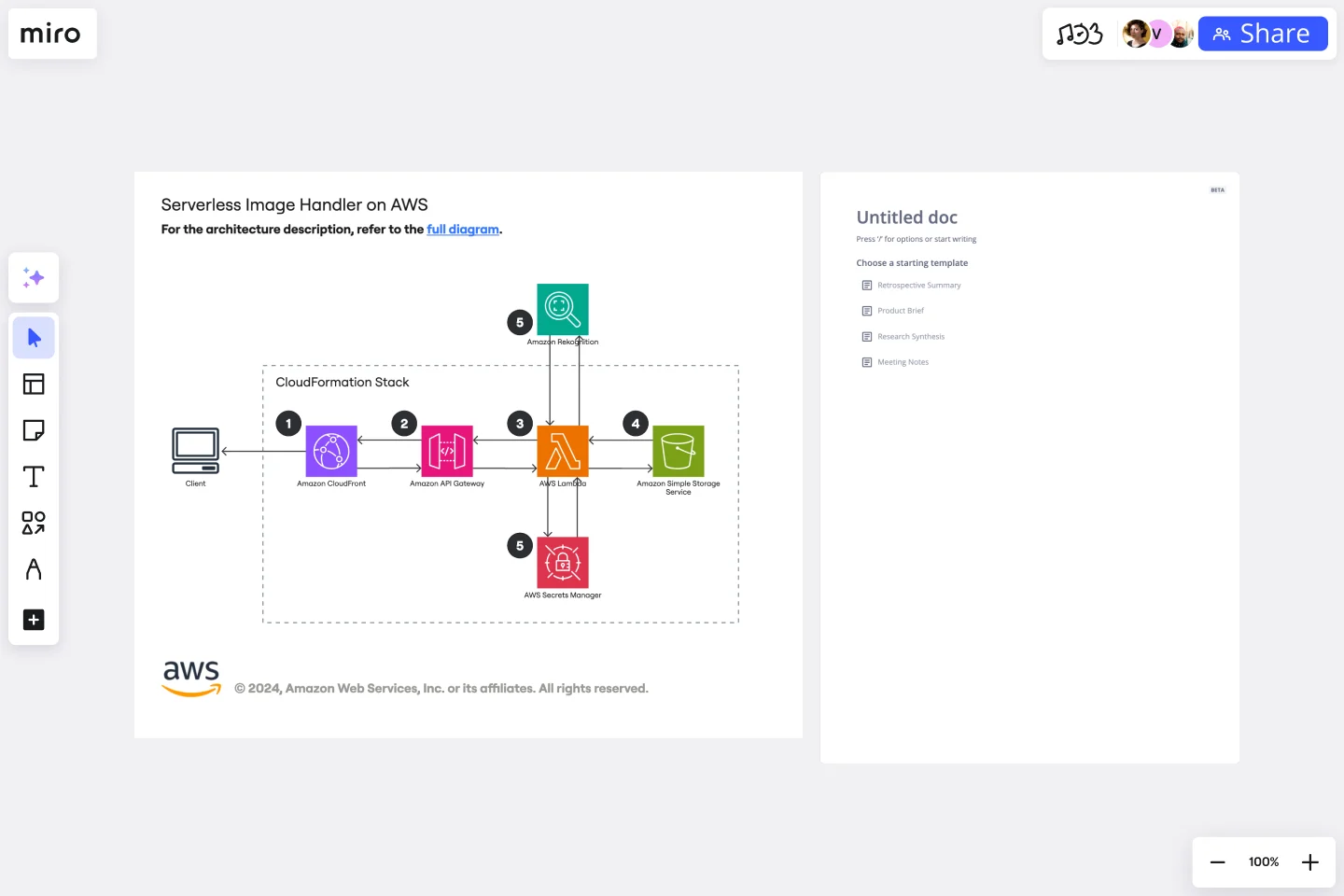Serverless Image Handler on AWS Template
Handle image management and transformation in cloud-based projects, eliminating the need for server infrastructure management with the Serverless Image Handler on AWS Template.
Available on Enterprise, Business, Education plans.
About the Serverless Image Handler on AWS Template
The Serverless Image Handler on AWS template is designed to streamline managing and transforming images in the cloud without needing to manage server infrastructure. This solution leverages AWS services to automatically handle common image manipulation tasks, such as resizing, cropping, and formatting, making it an efficient tool for applications requiring dynamic image management.
How to use the Serverless Image Handler on AWS Template
Edit the template: Use Miro's intuitive drag-and-drop interface to customize the template according to your project's requirements. You can add or remove shapes, and use relevant AWS shape packs.
Analyze and collaborate: Collaborate with team members by sharing insights and making real-time updates to the template.
Iterate and optimize: Based on your analysis and team feedback, iterate on your data connections and analysis within the template. Miro's flexible nature allows for continuous optimization of your data analysis processes.
Why use the Serverless Image Handler on AWS Template
Using the Serverless Image Handler on AWS template in Miro could offer several benefits, such as:
Efficiency: Automating image manipulation tasks directly within project boards can streamline workflows, especially for teams dealing with dynamic content or digital assets.
Scalability: Leveraging AWS's serverless architecture can help teams scale their image-handling needs without worrying about infrastructure.
Integration: For teams utilizing AWS for their projects, this template can provide a seamless way to incorporate cloud-based image handling into their Miro boards.
Get started with this template right now. Available on Enterprise, Business, Education plans.
Context Diagram Template
Works best for:
Business Management, Mapping, Diagrams
A context diagram is a perfect tool to view an entire system as a single process and understand how external factors interact with it. These external factors can include customers, developers, management, and more. The Context Diagram Template is your tool for creating this diagram.
Swimlane Diagram Template
Works best for:
Flowcharts, Diagrams, Workflows
A swimlane diagram shows you which stakeholders are responsible for each area of your critical processes. You can use it to understand current processes or plan new ones.
UML Sequence E-commerce Checkout Template
Works best for:
UML
The UML Sequence E-commerce Checkout Template in Miro is a versatile tool for visualizing and analyzing e-commerce checkout processes. It provides a step-by-step visual representation of system interactions, is highly customizable, supports real-time collaboration, and is suitable for various e-commerce platforms. It serves as an efficient documentation tool, fosters team collaboration, and contributes to a more streamlined checkout experience for customers.
Azure Demand Forecasting Template
Works best for:
Software Development, Diagrams
The Azure Demand Forecasting diagram will show the architecture of a demand forecast, making it easier for you to predict data consumption, costs, and forecast results. Azure is Microsoft’s cloud computing platform, designed to provide cloud-based services such as remote storage, database hosting, and centralized account management. Azure also offers new capabilities like AI and the Internet of Things (IoT).
Swimlane Diagram Template
Works best for:
Flowcharts, Diagrams, Workflows
A swimlane diagram shows you which stakeholders are responsible for each area of your critical processes. You can use it to understand current processes or plan new ones.
UML Diagram Template
Works best for:
Diagrams, Software Development
Originally used as a modeling language in software engineering, UML has become a popular approach to application structures and documenting software. UML stands for Unified Modeling Language, and you can use it to model business processes and workflows. Like flowcharts, UML diagrams can provide your organization with a standardized method of mapping out step-by-step processes. They allow your team to easily view the relationships between systems and tasks. UML diagrams are an effective tool that can help you bring new employees up to speed, create documentation, organize your workplace and team, and streamline your projects.
